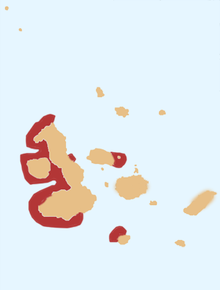Galapagos Penguin
| Galápagos penguin | |
|---|---|
 |
|
| Adult male swimming | |
| Scientific classification | |
| Kingdom: | Animalia |
| Phylum: | Chordata |
| Class: | Aves |
| Order: | Sphenisciformes |
| Family: | Spheniscidae |
| Genus: | Spheniscus |
| Species: | S. mendiculus |
| Binomial name | |
|
Spheniscus mendiculus Sundevall, 1871 |
|
 |
|
| Distribution of the Galápagos penguin | |
The Galápagos penguin (Spheniscus mendiculus) is a penguin endemic to the Galápagos Islands. It is the only penguin that lives north of the equator in the wild. It can survive due to the cool temperatures resulting from the Humboldt Current and cool waters from great depths brought up by the Cromwell Current. The Galápagos penguin is one of the banded penguins, the other species of which live mostly on the coasts of Africa and mainland South America.
The average Galápagos penguin is 49 centimetres (19 in) long and 2.5 kilograms (5.5 lb) in weight. It is the second smallest species of penguin after the little penguin. Galápagos penguins have a black head with a white border running from behind the eye, around the black ear-coverts and chin, to join on the throat. They have black-grey upperparts and whitish underparts, with two black bands across the breast, the lower band extending down the flanks to the thigh. Juveniles differ in having a wholly dark head, greyer on side and chin, and no breast-band. The female penguins are smaller than the males.
The Galápagos penguin is found primarily on Fernandina Island and the west coast of Isabela Island, but small populations are scattered on other islands in the Galápagos archipelago.
While ninety percent of the Galápagos penguins live among the western islands of Fernandina and Isabela, they also occur on Santiago, Bartolomé, northern Santa Cruz, and Floreana. The northern tip of Isabela crosses the equator, meaning that some Galápagos penguins live the northern hemisphere, the only penguins to do so.
The penguins stay in the archipelago. They stay by the Cromwell Current during the day since it is cooler and return to the land at night. They eat small schooling fish, mainly mullet, sardines, and sometimes crustaceans. They search for food only during the day and normally within a few kilometers of their breeding site. They depend on the cold nutrient-rich currents to bring them food.
...
Wikipedia

